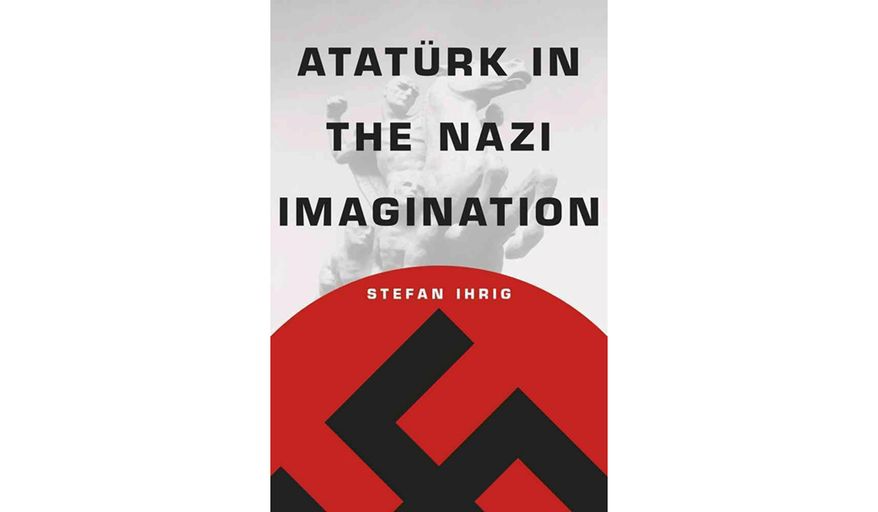 By Martin Rubin – – Tuesday, December 30, 2014
By Martin Rubin – – Tuesday, December 30, 2014Quite understandably, given their dire effect upon mankind, there have been countless studies of Nazism and its fuehrer Adolf Hitler, delving into all aspects of their nature. Worthy though so many of these are, perhaps even necessary, they tend to make one’s eyes glaze over at yet another book on the topic. So it is a surprise as well as a real pleasure to come across this insightful, instructive work, a genuinely original contribution to Nazi historiography.
It’s well-known that Nazism did not spring up out of nowhere: By the time Hitler came to power in 1933, he had role models aplenty. The best known was Italy’s fascist duce, Benito Mussolini, who had taken over his nation more than a decade earlier. But as Stefan Ihrig, a fellow at the Van Leer Jerusalem Institute, points out in “Ataturk in the Nazi Imagination,” there was another ruthless authoritarian leader with a raging cult of personality perhaps even more deeply rooted in the fuhrer’s mind, Turkey’s Kemal Ataturk.
The interface between Italian fascism and Nazism was obvious at the time of their contemporaneous flourishing and has continued to be front and center for historians, but few if any today remember the links between Hitler and Ataturk’s brutally modernized and revitalized Turkey. Mussolini’s March on Rome in late 1922, which brought him to power, is generally regarded as the inspiration for Hitler’s unsuccessful 1923 Munich Putsch. But Mr. Ihrig demonstrates conclusively that even more in the fore of Hitler’s thinking back then was Ataturk, whom he cited ahead of Mussolini. This was deeply significant, as author crisply explains:
“The distinction between Ataturk and Mussolini is significant. It highlights the importance not only of establishing a system of government founded on the Fuhrer principle but also of war and of ‘cleansing’ the country of minority populations and the opposition. These were the themes Third Reich texts were to explore through the prism of Turkey in depth.”
Certainly, Ataturk’s ruthless genocidal extermination of Armenian and other Christian minorities eerily foreshadow Hitler’s “Final Solution.” Mr. Ihrig is too scrupulous a historian to accept that Hitler actually uttered the words, “Who remembers the Armenians?” as an argument cum justification for the Holocaust, but there is no doubt that he was crucially aware of the dreadful precedent he certainly admired. As he did Ataturk’s ability to seize and control so many aspects of Turkish society.
Mr. Ihrig is well-versed in the relationship between Germany and Turkey, allies in World War I but with a more complicated relationship in the following decades. Weimar Germany, suffering under the draconian Treaty of Versailles imposed on them in 1919 by the victorious allies, admired the toughness and skill with which Turkey managed to reject the equally harsh terms of the Treaty of Sevres the next year, achieving in 1923 the much more favorable Treaty of Lausanne. Along the way, Mr. Ihrig uncovers fascinating bits of evidence of how large Ataturk loomed in Nazi Germany. His death happened to occur on Nov. 10, 1938, the day after the infamous anti-Jewish pogrom “Kristallnacht” or Night of Broken Glass. As Mr. Ihrig writes:
“The fact that Ataturk’s death was turned into a media event was also quite remarkable because this was anything but a ‘slow news day’ for the Nazis. The German papers were engaged in a serious propaganda battle against ‘the Jews.’ In short, the scarce space that a front page provided was needed to ‘spin’ the events and, one would think, was not available for foreign topics such as Ataturk’s death [yet] the ‘Reichskristallnacht’ spin and Ataturk’s death compete for domination over page 1.”
Clearly, when the author writes “Ataturk was no marginal figure in the Third Reich,” he is not exaggerating.
By the time one has finished Mr. Ihrig’s clearly written and highly informed account of this little-known aspect of Nazi historiography, it is easy to agree with his conclusion, “When we think of policy development, myths, goals, and the overall ideology of the Third Reich, we should always think about Turkey’s role for the Nazis. [T]he Nazis connected themselves, both quantitatively and qualitatively, to the other two ‘kindred systems,’ Fascism and Kemalism. In the minds of the Nazis (and the Italian Fascists, one might add) the three new systems — National Socialism, Italian Fascism, and Kemalism — were engaged in an ongoing dialogue throughout their existence.”
British historian Paul Johnson pointed out some time back that the totalitarian monsters of the 20th century, Lenin and Stalin, Hitler and Mussolini, eagerly borrowed horrendous methods from one another. Mr. Ihrig’s stimulating study makes us ponder, among so much else, the contribution that Ataturk’s capture and all-encompassing control of his nation and its people made to their evil works.
• Martin Rubin is a writer and critic in Pasadena, California.